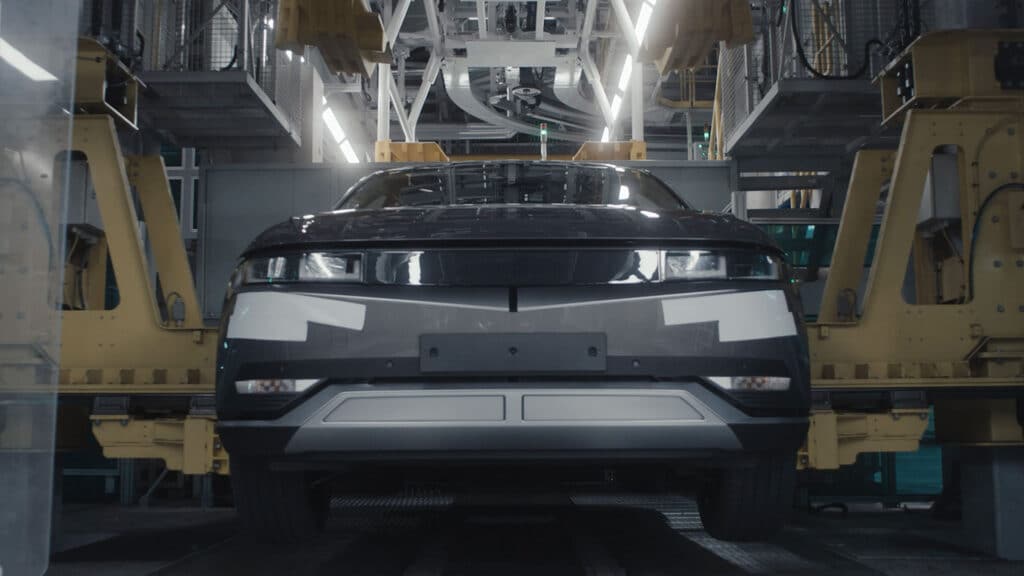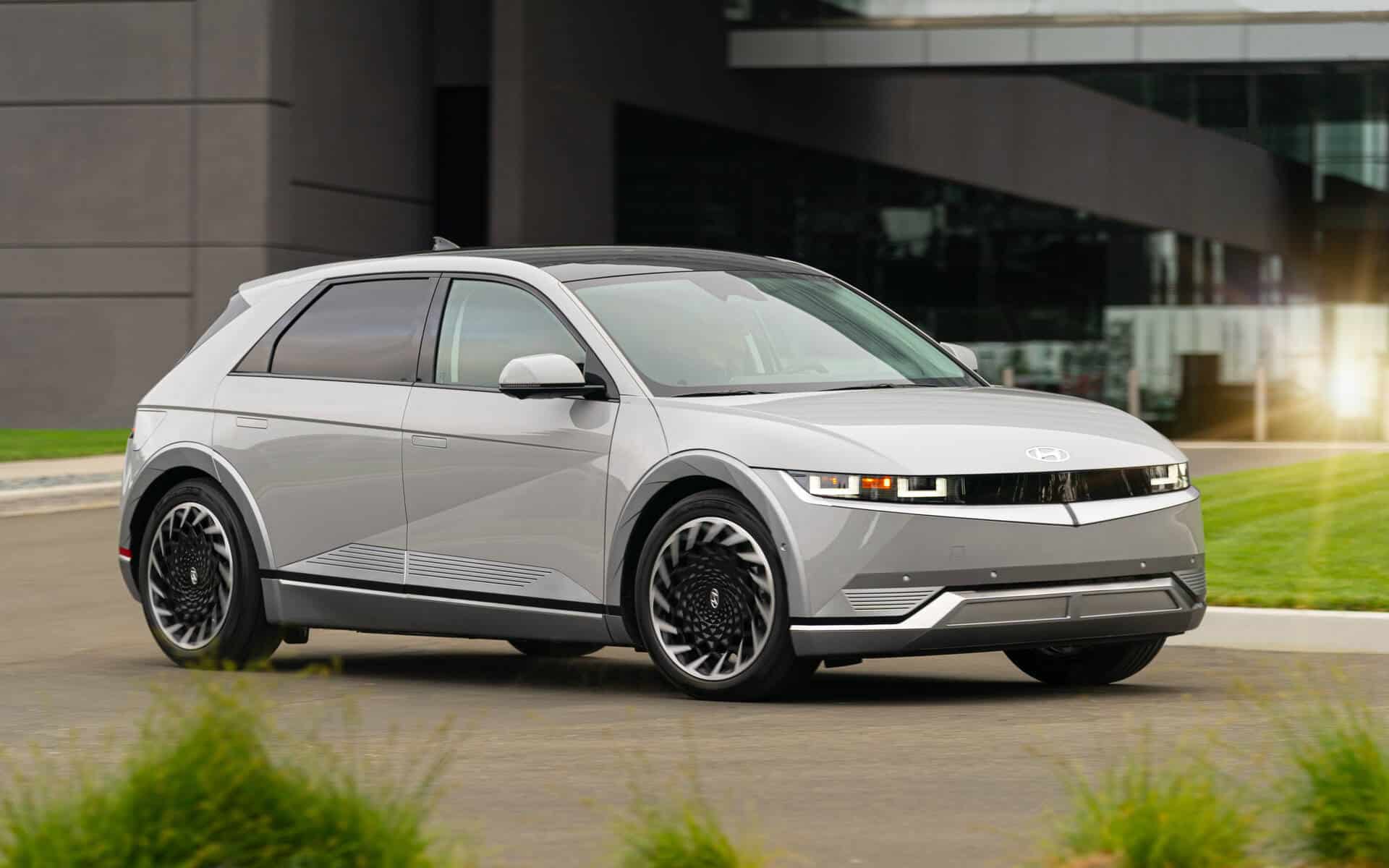Elegant and high-tech, the Hyundai Ioniq 5 is the brand’s third 100% electric car. Assembled on a new platform, it boasts sleek, futuristic lines. A multitude of intelligent features are available, as well as an ultra-fast 800V charging technology to take you further and further away!
Ioniq 5: Winner of the 2022 World Car of the Year
More energy in your life. More freedom, and more exceptional experiences to new electric horizons. Discover the new Hyundai Ionic 5. A 100% electric compact crossover. Nevertheless, competition is rare, but still present. The Ioniq 5’s most direct rival is of course the Tesla Model Y.


Exterior design
Ioniq 5 features the iconic styling of the EV 45 Concept, which was presented at the Frankfurt Motor Show in September 2019.
For a high-tech look, the one-piece hood stretches the full width of the vehicle and encompasses part of the fenders. The LED daytime running lights are composed of parametric pixels, offering a signature light pattern to the Korean crossover.
The front bumper is V-shaped and has integrated air intakes. These optimize engine cooling when open. When closed, they improve the vehicle’s aerodynamics.
The Ioniq 5 has a sporty silhouette thanks to its geometric Z-shaped line, which meets at the front and rear doors. An ultra-thin LED strip at the rear of the vehicle adds a touch of originality.
Also, the aerodynamic alloy wheels available in 19 and 20 inches give an electrifying design to the Ioniq 5. Finally, depending on the trim level, the door handles are retractable when the key is detected.



Interior design
Inside the cabin, the driver discovers two 12.3-inch digital screens side by side. The first, located behind the steering wheel, serves as an instrument panel (speedometer, battery charge, etc.). And the second, in the center of the dashboard, is a voice-activated multimedia screen.
The vehicle’s two front seats recline and offer premium comfort. Recline completely at the touch of a button for a recharge. Rear passengers also enjoy optimal comfort. The seats recline manually and slide 135 mm electrically.


Eco-responsible
Eco-responsibility is a core philosophy at Hyundai. In fact, the Hyundai Ioniq 5 contains 730 grams of cane sugar and corn mix, 294 grams of wool, 200 grams of linseed oil, up to 32 recycled plastic bottles, and 0.08 meters of recyclable fine paper.
As you can see, innovative and eco-friendly materials make this 100% electric crossover less dependent on petroleum-based products.



Car dimensions
The Hyundai electric Ioniq 5 has a neo-retro look and compact SUV dimensions. A length of 4.65 m, a width of 1.89 m and 1.65 m in height. Its wheelbase of 3 meters is impressive. The latter is larger than the electric Kona.
On the trunk side, the Hyundai Ioniq 5 has both front and rear cargo space. Rear trunk capacity increases from 527 liters, to nearly 1,600 liters with the rear seat folded down. Under the hood at the front, an additional 57 liters of space allows for easy storage of charging cables.
| Hyundai Ioniq 5 | Dimensions |
| Length | 4,635 mm |
| Width | 1,890 mm |
| Height | 1,647 mm |
| Wheelbase | 3,000 mm |
| Front and rear trunk | 57 liters – 531 liters |
| Trunk with seat folded down | Up to 1,600 liters |
| Traction capacity | 1,600 kg |
Where is the new Hyundai Ioniq 5 manufactured?
South Korea’s Hyundai Motor Co. is producing the all-electric Ioniq 5 model at its first plant in Southeast Asia. But to keep up with strong demand, Hyundai may consider expanding its electric car production capacity in America, with a new plant in Tennessee, or by upgrading lines at its existing plants in Georgia and Alabama.

Battery and autonomy
The Ioniq 5 offers two battery configurations: 58 kWh and 77 kWh. In the standard 77 kWh version, the manufacturer claims a range of up to 507 km. As for the 58 kWh battery, it allows a range of 384 km announced.
But beware, the autonomy of an electric car does not only depend on the capacity of the battery. It is important to take into account the speed at which the car is driven, the intensity of acceleration and braking, the number of passengers and the weight of luggage, the terrain of the road, the weather conditions, as well as the driving style of the driver.


Engines and performance
The HTRAC all-wheel drive version has two electric motors, while the two-wheel drive version has a single electric motor.
77 kWh battery:
| In its HTRAC version with all-wheel drive, Ioniq 5 has two electric motors. Placed on the front and rear axles, they offer a combined power of 325 hp (239 kW) 100 hp at the front and 225 hp at the rear. That’s 605 Nm of instant torque 255 Nm (front)/350 Nm (rear). It goes from 0 to 100 km/h in just 5.1 seconds. |
| In its two-wheel drive version, the Ioniq 5 has a 168 kW electric motor integrated into the rear axle. This offers 229 hp and 350 Nm of instantaneous torque. The 0 to 100 km/h time limit is 7.3 seconds. |


58 kWh battery:
| Only available in two-wheel drive. The Hyundai Ionic 5 features a 125 kW electric motor integrated into the rear axle, which delivers 170 hp and 350 Nm of instant torque. Acceleration from 0 to 100 km/h takes 8.5 seconds. |
Finally, regardless of the version chosen, the dynamic and sporty Ioniq 5 has a top speed of 185 km/h, and the air noise is fairly well channeled.



How to charge the Hyundai Ioniq 5 electric?
Ioniq 5 offers a multitude of charging options. At home at night, or via a fast charging station on the road (workplace, commercial area, parking lot, etc.), the latter speeds up charging times thanks to 400-800 V technology. With this new system, you can use a different type of charger depending on their availability.
Quick charge:
| 77 kWh battery: With a 350 kW (DC) charger, the battery can be recharged from 10% to 80% in 18 minutes. In 5 minutes of recharging 111 km of autonomy are recovered. With a 50 kW (DC) charger, the battery charges from 10% to 80% in 57 minutes. Additional range of 28 km after 5 minutes of charging. |
| 58 kWh battery: With a 350 kW charger, the battery can be recharged from 10% to 80% in 18 minutes. In 5 minutes of recharging 88 km of autonomy are recovered. With a 50 kW charger, the battery recharges from 10% to 80% in 44 minutes. Additional autonomy of 29 km after 5 minutes of recharge. |


Normal recharge :
| 77 kWh battery: At home on a Wallbox, or on a public AC terminal, the charging time is 6 h 6 mins. |
| 58 kWh battery: At your home on a Wallbox, or on a public terminal in alternating current (AC), the charging time is 5 hours. |
Waiting at charging stations and the fear of running out of gas will be a thing of the past with the Hyundai Ionic 5.


Finishes: which Ioniq 5 to choose?
The Korean crossover comes in three different trims: Intuitive, Creative, Executive. Each of them offers a wide range of equipment. All you have to do is choose the one that suits you best:
Intuitive
| Electric parking brake with auto-hold function |
| Battery heating system |
| Power transmission |
| Tinted rear windows |
| Etc. |
Creative (in addition to the Intuitive version)
| Bi-LED front lights |
| Retractable exterior door handles |
| 19 inch alloy wheels |
| Electrically adjustable driver’s seat |
| Etc. |
Executive (in addition to the Creative version)
| Panoramic glass roof |
| Heated front and rear seats |
| Head-up display on windshield with augmented reality |
| Autonomous emergency braking with intersection functions |
| Etc. |
Executive + 20″ wheels (in addition to the Executive version)
| 20 inch rims |
Hyundai Ioniq 5 : its price
The Hyundai Ioniq 5 starts at €46,500 excluding environmental bonus, in its entry-level version with its 58 kW battery. For the battery with a larger capacity, the price starts from 49 700 €.
| Finishes | Hyundai Ioniq 5 (58 kWh) | Hyundai Ioniq 5 (77 kWh) |
| Intuitive | 46 500 € | 49 700 € |
| Creative | 49 300 € | 52 500 € |
| Executive | – | 58 500 € |
| Executive + jantes 20″ | – | 58 900€ |
| Executive HTRAC | – | 62 400 € |


Our opinion
The Hyundai Ionic 5 is a crossover that turns heads. With its unique style, it makes a statement in an often gloomy automotive environment. Comfortable and spacious, the interior is a pleasure to live in.
The performance and driving of this electric car are appreciable. As far as autonomy on fast lanes is concerned, it is possible to remain “hungry”. Indeed, the team of Circulerpropre knew better.
